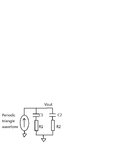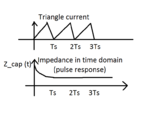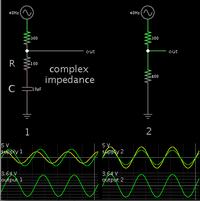bhl777
Full Member level 6
Hi All, I have a circuit like this:

Different resistors R1 and R2 are connecting with different capacitors C1 and C2 in separately. A periodic triangle wavefomr current is charging the capacitors and resistors, and produce a periodic output voltage.
Currently I am trying to calculate the peak to peak ripple of the output voltage. One way is to use laplace transform to apply in current (I(s)) RC network (Z(s)) to calculate Vout(s)=I(s)*Z(s), then use inverse laplace transform to calculate Vout(t).
However, it is not easily done by hand calculation, and I was trying to use the convolution between "I(t)" and "the inverse laplace transform of Z(s)" to calculate Vout (t). However, what I got from the spreadsheet and SPICE simulation does not match.
I have the following questions:
(1) Is this the correct approach to go, by converting the multiplication is frequency domain to the convolution of time domain?
(2) I have never heard of the impedance in time domain, which is L-1{Z(s)}(inverse L transform), is it the right way to calculate the convolution of I(t) and Z(t) to get Vout(t)
(3) If that is not the right way, which is the best way for hand calculation/EXCEL spreadsheet to implement? It seems like for this case, using the calculation in s-domain and then inverse L transform is only feasible in SPICE but not in hand analysis.
Thank you!

Different resistors R1 and R2 are connecting with different capacitors C1 and C2 in separately. A periodic triangle wavefomr current is charging the capacitors and resistors, and produce a periodic output voltage.
Currently I am trying to calculate the peak to peak ripple of the output voltage. One way is to use laplace transform to apply in current (I(s)) RC network (Z(s)) to calculate Vout(s)=I(s)*Z(s), then use inverse laplace transform to calculate Vout(t).
However, it is not easily done by hand calculation, and I was trying to use the convolution between "I(t)" and "the inverse laplace transform of Z(s)" to calculate Vout (t). However, what I got from the spreadsheet and SPICE simulation does not match.
I have the following questions:
(1) Is this the correct approach to go, by converting the multiplication is frequency domain to the convolution of time domain?
(2) I have never heard of the impedance in time domain, which is L-1{Z(s)}(inverse L transform), is it the right way to calculate the convolution of I(t) and Z(t) to get Vout(t)
(3) If that is not the right way, which is the best way for hand calculation/EXCEL spreadsheet to implement? It seems like for this case, using the calculation in s-domain and then inverse L transform is only feasible in SPICE but not in hand analysis.
Thank you!

